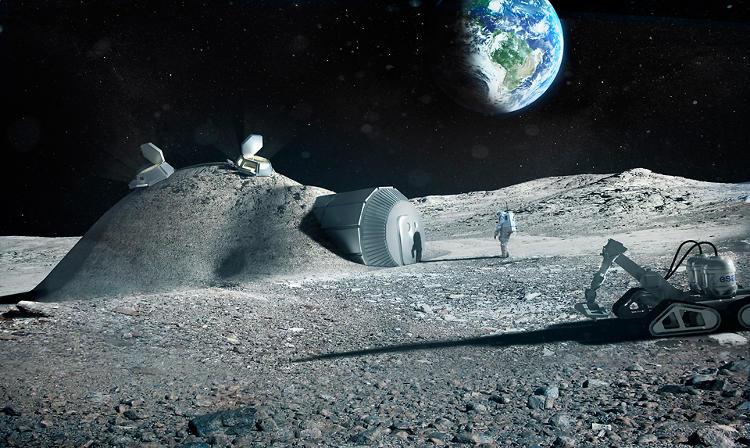When you consider humans building a base on another rock floating in space, you usually think of those science fiction books you read back in high school. Fairly soon, such an accomplishment will not be the work of a science fiction writer, but instead the work of NASA, The ESA, or perhaps even a private company.
Although there are no immediate plans to build a base on our Moon, recent technological advances, as well as innovative ideas, will soon make such a project very possible. 3D printers, along with robotics could work together to make such a project cheaper, less risky, and much more likely to succeed than most experts believed just a year or two ago.
 Prior to the advent of 3D printing, the idea of building a base on any planet, asteroid, or moon would be completely impractical. The costs of carrying materials to the moon would be so substantial, that it would make any such project dead on arrival. This has all changed. Theoretically, to 3D print a base on the Moon, the only material needed, in addition to a typical NASA mission, would be the printer itself, some sort of bonding agent, which would be used to solidify Moon dust into structures and a few tools.
Prior to the advent of 3D printing, the idea of building a base on any planet, asteroid, or moon would be completely impractical. The costs of carrying materials to the moon would be so substantial, that it would make any such project dead on arrival. This has all changed. Theoretically, to 3D print a base on the Moon, the only material needed, in addition to a typical NASA mission, would be the printer itself, some sort of bonding agent, which would be used to solidify Moon dust into structures and a few tools.
The technology to print large concrete structures is already here. It’s called contour crafting, and has been researched on by Behrokh Khoshnevis of the University of Southern California’s Information Sciences Institute. He has also been working with NASA for almost four years, trying to come up with the correct schematics for printing out both Moon and Martian bases in the future. According to Khoshnevis, such bases could be printed using 90% Moon dust, meaning Astronauts would be responsible for transporting the other 10%. This small fraction of materials would likely be made up of the bonding agents used within the concrete like substance extruded from the printer. You can see an example of contour crafting, using a large 3D printer in the video below:
“3-D printing offers a potential means of facilitating lunar settlement with reduced logistics from Earth,” said the ESA’s Scott Hovland
 Already, scientists in Italy have been able to actually test print structures, using a material which has 99.8% the same composition as Moon dust. The material was accidentally discovered within an Italian volcano. There are still several obstacles to overcome, all which seem possible in the next few years. Temperatures on the Moon, the lack of gravity, and dangers to humans working the machines, all need to be factored into any final plan that may one day be set into action.
Already, scientists in Italy have been able to actually test print structures, using a material which has 99.8% the same composition as Moon dust. The material was accidentally discovered within an Italian volcano. There are still several obstacles to overcome, all which seem possible in the next few years. Temperatures on the Moon, the lack of gravity, and dangers to humans working the machines, all need to be factored into any final plan that may one day be set into action.
Discuss the future prospects of a 3D printed base on the moon here: https://3dprintboard.com/showthread.php?1680-3D-Printing-a-Moon-Base
Subscribe to Our Email Newsletter
Stay up-to-date on all the latest news from the 3D printing industry and receive information and offers from third party vendors.
You May Also Like
Further Understanding of 3D Printing Design at ADDITIV Design World
ADDITIV is back once again! This time, the virtual platform for additive manufacturing will be holding the first-ever edition of ADDITIV Design World on May 23rd from 9:00 AM –...
3D Printer Maker EVO-tech Reborn as NEVO3D — Once More With Feeling
EVO-tech was a 3D printing service and original equipment manufacturer established in 2013 and based in Schörfling am Attersee, Austria. The company produced high-quality material extrusion systems featuring linear bearings,...
3D Systems Brings 3D Printed PEEK Cranial Implant to the U.S. with FDA Clearance
For more than 10 years, 3D Systems (NYSE:DDD) has worked hand-in-hand with surgeons to plan over 150,000 patient-specific cases, and develop more than two million instruments and implants from its...
CDFAM Returns to Berlin for Second Annual Symposium
The second CDFAM Computational Design Symposium is scheduled for May 7-8, 2024, in Berlin, and will convene leading experts in computational design across all scales. Building upon the first event...































